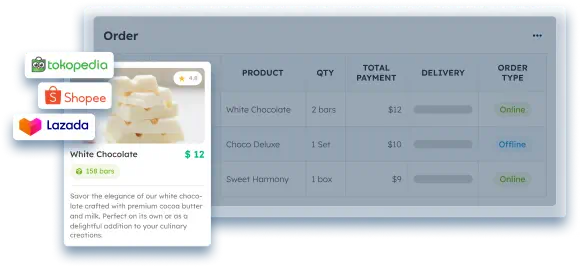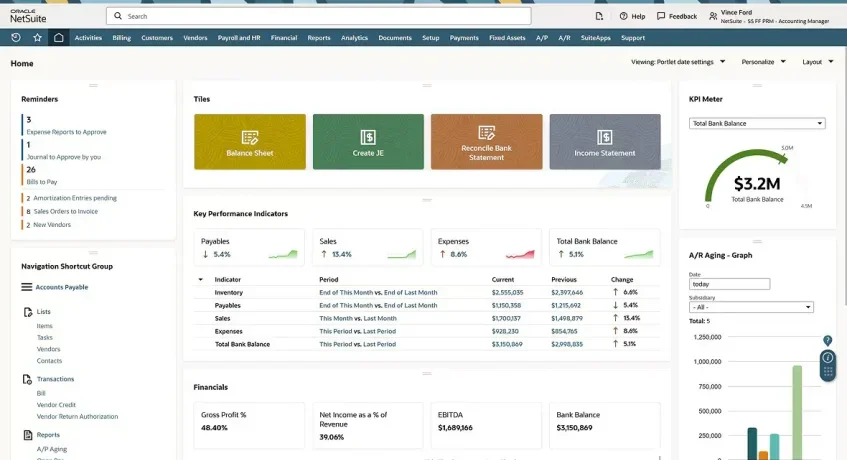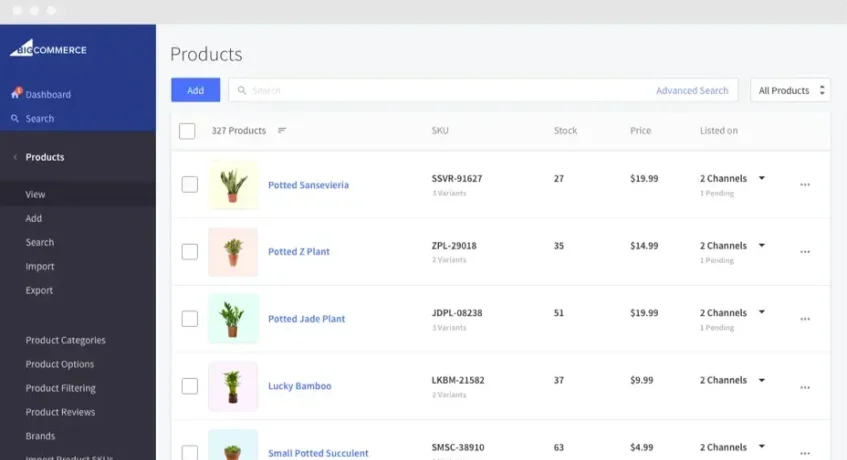Businesses in Singapore’s fast-paced retail industry face challenges such as fragmented systems, inefficient processes, and a lack of end-to-end office integration. A Retail Management System (RMS) addresses these difficulties by seamlessly linking all areas of the business.
According to IMDA, qualifying SMEs can receive funding assistance through various business awards, including the Productivity Solutions Grant (PSG) and others listed on the Business Grants Portal. These awards enable firms to overcome inefficiencies and implement technologies such as Retail Management Systems (RMS).
This article explores the top retail management systems in Singapore, including ScaleOcean, Microsoft Dynamics 365, Oracle NetSuite, and others. We’ll go over their features, benefits, and why they’re critical for driving growth in the competitive retail sector.
- A Retail Management System (RMS) is a centralized software that combines key retail tasks, including POS sales transactions, inventory management, and customer relationship management.
- The best retail management systems in Singapore include ScaleOcean, Microsoft Dynamics 365, Oracle NetSuite, Lightspeed Retail, BigCommerce, BrightPearl, and others
- How to choose the right RMS, first, it’s crucial to assess your needs, evaluate vendors, prioritize integrations, and ensure proper team training and vendor support.
- ScaleOcean’s retail ERP software is built to solve these challenges, offering a scalable, all-in-one solution to unify your operations and drive sustainable growth.

What is a Retail Management System (RMS)?
A Retail Management System (RMS) is a centralized software platform that brings together important retail operational tasks. It includes sales transactions at the point of sale (POS), inventory management, and customer relationship management, giving a clear picture of corporate performance.
By combining these functions, an RMS minimizes the need for several unconnected software systems. This integration reduces errors caused by manual data entry, ensures consistency across departments, and provides a single source of truth for retail data.
How an RMS Benefits Your Retail Business in Singapore
Implementing a retail management system (RMS) improves productivity and gives firms greater control over procedures, which is essential for success in Singapore’s competitive industry. It automates tasks, delivers customer information, and contributes to a smarter, more lucrative retail organization. Key advantages include:
1. Increased Efficiency through Automation
Honestly, many of those day-to-day retail tasks can feel really repetitive and just soak up valuable time, think updating stock counts or churning out daily sales reports, for instance. A good retail management system automates tasks, allowing staff to focus on more valuable work, like providing excellent customer service, boosting productivity.
It’s quite remarkable how tasks that used to take hours can now be completed in just minutes thanks to automation, and this really does significantly improve overall productivity for any retail store management system. Your team can spend less time on admin tasks and more time engaging with customers, making better use of their skills.
2. Data-Driven Decision-Making
A really good retail management system, or retail software, will diligently collect a massive amount of data from every single transaction, every customer interaction, and all inventory movements within your store. It transforms raw data into easy-to-understand reports and analytics, providing valuable insights.
With this kind of data, you can quite easily spot your best-selling products, understand when your peak sales hours actually are, and clearly see which marketing campaigns are really hitting the mark. This information allows you to make informed, strategic decisions rather than guesswork, which is a big benefit for any retail organization.
3. Reduced Operational Costs
By genuinely improving efficiency and giving you far better control over your day-to-day operations, a retail management system directly helps to lower costs, which is a pretty tangible benefit. Better inventory management helps avoid overstocking, reducing capital tie-up and storage costs, leading to savings.
Automation, naturally, also lessens the need for quite a bit of manual labour, effectively cutting down on administrative overhead for your retail store management. An RMS helps identify inefficiencies and waste, allowing you to take proactive steps to reduce expenses and improve profitability.
4. Enhanced Customer Experience
A strong retail management system improves the consumer experience by providing rapid checkouts, accurate stock information, and personalized assistance. It increases consumer loyalty by providing seamless service, such as verifying product availability across multiple stores or online.
The system also helps manage loyalty programs and targeted marketing initiatives, which improves customer outreach. Integrating with top retail apps can improve the overall experience, making it more interesting and individualized for each buyer.
5. Seamless Omnichannel Operations
Let’s be honest, modern customers these days shop across a multitude of channels—think in-store, online, on their mobile devices, and so on, and they expect it all to just flow together. A good retail management system is essential for creating a seamless omnichannel experience, a must-have for any retail store.
What this really means in practical terms is that a customer can effortlessly buy a product online and then return it in-store without any hassle whatsoever, which is a huge convenience. It ensures accurate stock levels across all channels, preventing issues like selling out-of-stock items online.
6. Scalability for Growth
It’s a given that as your retail business grows, your operational needs will undoubtedly become more complex. That’s just the nature of scaling. A really good retail management system is purposefully designed to scale right alongside you, which is a critical element for future planning.
This inherent scalability effectively saves you from the often costly and incredibly disruptive process of having to completely switch systems every time your business expands, which is a considerable relief. It provides a stable foundation to support your growth ambitions, acting as a reliable backbone for your retail store.
Core Features of a Comprehensive Retail Management System

When selecting a retail management system, it’s critical to grasp the elements that make it effective and complete. Look for a system that integrates all important aspects of your business, from front-end customer checkout to back-end reporting. The key features include:
1. Point of Sale (POS)
You know, the Point of Sale, or POS system, it’s truly the absolute heart of any retail operation, because that’s just where all the actual money transactions are happening. A really good, modern POS within a retail management system does way more than simply processing payments.
When you’re looking, make sure that POS can handle all sorts of payment types, like your usual credit cards, mobile payments, and even gift cards, because customers expect options these days. It’s also super important that it can keep working offline, just in case your internet decides to go down unexpectedly.
2. Inventory Management
Let’s be real, having effective inventory management is just absolutely crucial for keeping your business profitable, it really is. Your retail management system should give you real-time updates on all your stock levels across every single one of your locations, including the warehouse and your online store.
A top recommendation order fulfillment system should include features like automated reordering when stock hits certain levels, easy transfers between stores, and the ability to manage product variations like sizes and colors. Good inventory management prevents overstocking or stockouts.
3. Customer Relationship Management (CRM)
Truly, building up those strong, lasting relationships with your customers is just so key for any kind of long-term success in retail. A CRM module, if it’s built right into your system, lets you gather and manage all sorts of customer data, like their contact details, what they’ve bought before, and even their preferences.
Having a good CRM means you can actually craft really targeted marketing campaigns, easily manage your loyalty programs, and generally just offer much better customer service, which customers definitely appreciate. Imagine your staff quickly accessing a customer’s purchase history to offer relevant suggestions.
4. E-commerce and Omnichannel Integration
If you’re selling online or considering it, a flawless connection with your e-commerce platform is critical. According to Enterprise SG, Enterprise Singapore and the Ministry of Home Affairs (MHA) have introduced OCRM for shops and ISM for security agencies, respectively.
This kind of integration means your customers get a really consistent experience, whether they’re browsing online from home or walking into your actual store, which is pretty important for loyalty. It simplifies back-end operations by allowing you to manage everything from one system, saving time.
5. Employee Management
Your staff, they’re truly your most valuable asset, and it’s good to know a retail management system can actually help you manage them a lot more effectively. Often, these systems come with handy features like employee time tracking, keeping an eye on sales performance, and offering role-based access controls, too, which is quite useful.
When you track sales performance for each employee, you can easily spot your top performers and also figure out where targeted training might really be needed, which is a big plus for development. It also simplifies the whole payroll process considerably, because hours worked are recorded so accurately, which helps avoid headaches.
6. Reporting and Analytics
Honestly, the capability to generate really detailed reports is hands down one of the absolute most powerful features you’ll find in any retail management system. The system should provide customizable reports on sales, inventory, customer data, and employee performance, as all of this information is crucial.
You’ll definitely want to look for a system that has an intuitive dashboard, something that gives you a quick, clear overview of all your key performance indicators, or KPIs, right away. You should also be able to really dig down into that data, finding opportunities you might otherwise miss and tackling potential issues head-on, which is super useful.
7. Financial Management
A truly comprehensive retail management system, it quite often includes some basic financial management features, or at least really good accounting integration, which is a big help. This might mean managing accounts payable and receivable, integrating with your general ledger, and offering solid financial reporting, too, which covers a lot of ground.
By simply integrating with well-known accounting software, like Xero or QuickBooks, your retail management system can automatically sync all your sales data, which just gets rid of that tedious manual data entry. It saves time, reduces errors, and keeps your financial records accurate and up-to-date.
The 7 Best Retail Management Systems in Singapore
Choosing the best retail management system in Singapore can be difficult due to the numerous options available. Each system has distinct advantages, so it is critical to choose one that meets your company’s objectives and budget. Here are the top seven retail management systems to consider:
1. ScaleOcean’s Retail ERP System

ScaleOcean’s retail ERP software is a powerful solution tailored to the needs of modern Singapore shops. It provides a comprehensive suite of capabilities that includes POS, inventory management, CRM, and e-commerce, resulting in a consolidated platform for all business processes.
ScaleOcean’s all-in-one ERP solution combines POS, inventory, CRM, accounting, and e-commerce on a single, scalable platform. It is designed for both emerging and established enterprises in Southeast Asia, providing flexibility to address changing retail needs in a dynamic market.
ScaleOcean offers a free demo of its retail management solution, allowing firms to learn how the program may improve operations. ScaleOcean is also integrated with Singapore’s CTC grant, which provides further support for enterprises wanting to increase their technological efficiency.
Key Features:
- POS Integration: Seamlessly integrates Point of Sale (POS) systems with inventory and CRM for smooth, real-time transactions and customer management.
- Inventory Management: Efficiently tracks stock levels and manages product movement across multiple sales channels, ensuring accurate and real-time data.
- Customer Relationship Management (CRM): Consolidates customer information to deliver personalized experiences, enhance loyalty, and improve customer satisfaction.
- Real-Time Reporting and Analytics: Provides actionable insights with real-time reporting, helping businesses make informed decisions to optimize operations and sales.
- Omnichannel Integration: Manages sales and inventory across all channels, ensuring consistent and synchronized operations for both online and offline retail environments.
| Pros | Cons |
|---|---|
|
|
Best For: ScaleOcean ERP is suitable for Singaporean businesses looking for a comprehensive solution to manage their whole retail operation and supply chain. It establishes a single source of truth, reducing company operations, increasing efficiency, and ensuring consistent data across all departments.
2. Microsoft Dynamics 365 Retail System
Microsoft Dynamics 365 is a comprehensive suite of business applications, and it includes some truly powerful retail capabilities as part of its offering. This enterprise-grade solution is ideal for large retail chains with complex operations, offering integration with other business tools like Office 365 and Power BI for enhanced functionality.
Its biggest strength probably lies in its extensive customisation options and the advanced AI-powered analytics it boasts. However, its sheer complexity can be a barrier for smaller businesses. It’s generally best for companies needing a highly configurable and powerful enterprise solution.
Key Features:
- Comprehensive suite of business applications
- Seamless integration with Office 365 and Power BI
- Advanced AI-powered analytics
- Highly customizable to fit complex business needs
- Scalable to support global retail operations
| Pros | Cons |
|---|---|
|
|
Best For: Large retail companies with intricate operations, especially those with a global presence, that require highly customized, integrated business solutions are the ideal candidates for Microsoft Dynamics 365.
3. Oracle NetSuite Retail Management Solution

Oracle NetSuite is another big name in cloud-based ERP systems, offering a pretty strong retail management solution known as SuiteCommerce. It works as a unified platform, handling e-commerce, POS, and all those back-office operations in one go, and NetSuite is quite well-known for its financial management and inventory control features.
Much like Dynamics 365, this is a comprehensive solution, often proving a better fit for mid-sized to larger businesses because of its complexity. It’s notably scalable, capable of supporting retailers with international operations, and really, it’s a good choice for businesses that truly prioritize a single, integrated system for their entire operation.
Key Features:
- Unified platform for e-commerce, POS, and back-office
- Strong financial management capabilities
- Advanced inventory control and supply chain management
- Scalable for international operations
- Real-time analytics and reporting
| Pros | Cons |
|---|---|
|
|
Best For: For mid- to large-sized organizations, Oracle NetSuite is the best option, particularly for those that operate internationally and require an integrated ERP solution that addresses financial management, inventory control, and e-commerce.
4. Lightspeed Retail Retail Management Systems
Lightspeed Retail is a widely one of the popular cloud-based POS and retail management systems, particularly well-suited for the small to medium-sized business segment. It offers a user-friendly interface and strong inventory management, making it suitable for businesses like boutiques, bike shops, and jewelers focused on in-store retail.
While it does offer e-commerce capabilities, its primary strength is undeniably its powerful POS system. It provides excellent reporting tools and integrates smoothly with a broad range of third-party applications, making it a solid choice for retailers needing a simple yet great solution to manage their stores effectively.
Key Features:
- User-friendly POS system for in-store operations
- Strong inventory management tools
- E-commerce integration for omnichannel retail
- Reporting and analytics for better business insights
- Integrates with various third-party applications
| Pros | Cons |
|---|---|
|
|
Best For: For small to medium-sized businesses seeking a user-friendly, integrated point-of-sale and retail management system with robust inventory and reporting features, Lightspeed Retail is the ideal choice.
5. BigCommerce Omnichannel Retail System

BigCommerce, though primarily an e-commerce platform by origin, has really evolved to offer some strong omnichannel retail capabilities these days. It’s a great option for businesses with an online presence, offering tools to integrate online and physical store operations for a unified customer experience.
The platform is also quite well-regarded for its flexibility and open architecture, which allows for extensive customisation, a big plus for those retailers aiming to build a really unique online brand. It’s particularly strong, you could say, for businesses focused squarely on driving growth through e-commerce.
Key Features:
- Omnichannel retail capabilities
- Seamless integration with online and physical stores
- Flexible and open architecture for customization
- Comprehensive e-commerce tools
- Strong focus on driving online growth
| Pros | Cons |
|---|---|
|
|
Best For: BigCommerce offers a smooth omnichannel retail experience along with robust growth capabilities, making it the ideal choice for e-commerce-focused companies looking to merge their online and offline operations.
6. BrightPearl Retail Operating System
Brightpearl is positioned as a retail operating system specifically designed for omnichannel merchants, with a keen focus on automating all those critical back-office processes like inventory management, order fulfillment, and even accounting. It manages high-order volumes, ideal for fast-growing e-commerce and omnichannel brands.
It integrates seamlessly with most major e-commerce platforms, marketplaces, and various POS systems, though it’s important to note that Brightpearl isn’t a POS system itself. Rather, it acts as the central hub connecting all your retail channels. This makes it ideal for businesses whose main goal is to streamline their post-purchase operations.
Key Features:
- Omnichannel retail management
- Advanced automation for back-office processes
- Real-time order management
- Seamless integration with e-commerce platforms
- Central hub for inventory and financial data
| Pros | Cons |
|---|---|
|
|
Best For: For multichannel retailers and rapidly expanding e-commerce companies that require real-time inventory and order management as well as back-office process automation, BrightPearl is the perfect solution.
7. Retail Pro Software
Retail Pro has been around for a while as a long-standing and trusted retail management software, used by retailers globally. Known for its flexibility, this system can be tailored to various retail sectors, covering POS, inventory management, and customer relations with a focus on international retail.
This software is also highly customisable and offers deployment options both on-premise and in the cloud, which is helpful. It’s a robust solution, particularly for specialty retailers with those more unique requirements, making Retail Pro a good choice for established businesses seeking a proven and adaptable platform.
Key Features:
- Highly customizable for various retail sectors
- Offers both on-premise and cloud deployment options
- Comprehensive POS and inventory management tools
- Strong customer relationship management (CRM) features
- Support for international retail operations
| Pros | Cons |
|---|---|
|
|
Best For: Specialty merchants and well-established companies that need a highly adaptable, versatile solution for both on-premise and cloud retail management are the ideal candidates for Retail Pro.
How to Choose and Implement the Right RMS
Implementing a retail management system (RMS) is a key step that can improve your company’s operations. To achieve success, properly organize your strategy, examine your requirements, research vendors, and prepare your team. Key steps for successful RMS deployment are:
1. Assess Your Needs
First off, you really need to dig deep into your current operations and figure out exactly what your retail store management system needs. Identify your current challenges and list must-have and nice-to-have features to guide your system selection.
It’s smart to get everyone involved, like your store managers, inventory folks, and even marketing staff, because their input is crucial to choosing a system that genuinely works for everyone. Honestly, this initial assessment is probably the single most critical step in the entire process for any retail management software.
2. Choose the Right Solution
After you’ve got a solid grasp on your requirements, it’s time to really start digging into and evaluating various RMS solutions out there. Request demos from shortlisted vendors to see the software in action and ask detailed questions to ensure it addresses your specific needs.
It’s not just about the features, though. You should absolutely look at the vendor’s reputation, their industry experience, and what their other customers are saying. Compare pricing models, implementation, subscriptions, and hidden fees to ensure you get the best value for your investment.
3. Prioritize Integrations with Your Existing Tools
Your new retail management system really needs to play nicely with your current software, things like your accounting system, e-commerce platform, or even your payment processor. Ensure the system integrates seamlessly with your existing tools, saving time and avoiding the hassle of manual data transfer.
Definitely ask vendors for a clear list of their standard integrations, and don’t forget to inquire about custom options if your needs are unique. A retail software solution that connects effortlessly with your existing tech stack is going to make the whole implementation process far smoother, leading to a much more unified and efficient workflow overall.
4. Train Your Team to Maximize Adoption
A new retail management system is only as effective as its users. Therefore, thorough training is essential. The vendor should give resources such as in-person meetings, online tutorials, and detailed documentation to help your team navigate the move and ensure a smooth adoption.
It’s also smart to plan for ongoing training, both for new hires getting up to speed and for existing staff when new features roll out. Getting your team to really adopt the system from day one is vital for maximizing your return on investment, because a truly well-trained team will be able to leverage the full power of your new retail management system.
5. Ensure Responsive Vendor Support is Available
Even with the best software and training, problems will occur. That’s why prompt vendor support is critical. Before committing, look into their support choices, including hours, response times, and contact methods, as quality assistance is critical for smooth operations.
Aim for a vendor that provides multiple ways to get help, phone, email, live chat, you name it. Check reviews or ask for references to gauge customer service quality. Knowing support is readily available ensures peace of mind and quick, efficient problem resolution.
Conclusion
In Singapore’s thriving retail business, success extends beyond exceptional products. Efficient operations, data-driven insights, and a superior customer experience are what actually distinguish firms. A strong retail management system is essential for modern retail operations, serving as a key tool.
Choosing the right RMS is crucial for your business. ScaleOcean’s retail ERP solution helps streamline inventory, customize customer interactions, and optimize operations. Investing in ScaleOcean ensures a competitive, profitable future, and with ScaleOcean offering a free demo, you can experience the benefits of their software firsthand.
FAQ:
1. What are the 4 types of inventory management systems?
The four types of inventory management systems are: manual, barcode-based, periodic, and perpetual. Each system differs in how inventory is tracked, with the perpetual system offering real-time tracking and accuracy across multiple locations.
2. What are the 7 P’s of retail management?
The 7 P’s of retail management are: Product, Price, Place, Promotion, People, Process, and Physical Evidence. These elements guide retailers in creating effective strategies for product offerings, customer satisfaction, and overall retail experience.
3. How to calculate the RMS?
RMS (Retail Management System) calculation involves analyzing key metrics such as sales per square foot, inventory turnover, and customer retention rates. Use formulas like sales divided by the number of customers to determine efficiency and profitability for the store.
4. How does RMS work?
An RMS works by integrating various retail processes, including sales, inventory, and customer relationship management, into a single platform. It tracks product movement, manages stock levels, and enhances customer interaction, improving overall operational efficiency and profitability.







 PTE LTD..png)
.png)

.png)








.png)
.png)
















